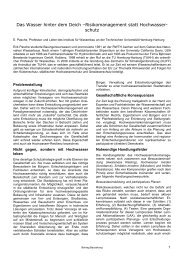Coastal Protection and Sea Level Rise - Hochwasser
Coastal Protection and Sea Level Rise - Hochwasser
Coastal Protection and Sea Level Rise - Hochwasser
You also want an ePaper? Increase the reach of your titles
YUMPU automatically turns print PDFs into web optimized ePapers that Google loves.
14<br />
3. Integrated 2. The Natural BEP Solutions System<br />
changes in sea-level <strong>and</strong> wave climate are underway.<br />
They suggest that in larger tidal systems,<br />
the breakpoint might be situated lower than in<br />
smaller systems (Van Goor 2002). In general, the<br />
simulations support the assumptions made in the<br />
first CPSL report (see above).<br />
In the Wadden <strong>Sea</strong> Quality Status Report (2005,<br />
Ch. 3.4) it is stated that: “tidal flats are expected<br />
to be able to keep up with sea level rise due to<br />
faster sedimentation up to a critical limit of sea<br />
level rise of 3 mm/yr (for large tidal basins) to 6<br />
mm/yr (for small basins). For salt marshes, this<br />
critical limit is at least 8.5 mm/yr, <strong>and</strong> for the<br />
pioneer zone 3-6 mm/yr. Above the critical limit<br />
flats <strong>and</strong> marshes will ‘drown’. The increasing<br />
sediment dem<strong>and</strong> in the tidal basins will trigger<br />
a faster erosion of the s<strong>and</strong>y North <strong>Sea</strong> coasts.<br />
Combined with the direct effect of a rising water<br />
level, it is estimated that the total coastal erosion<br />
will increase by 250% of the present level of 6<br />
mm/yr <strong>and</strong> by 330% at 8.5 mm/yr. This can be<br />
compensated for by nourishments”.<br />
Another aspect that needs to be addressed<br />
here, is the inherent natural variability. In a<br />
positive sense, it implicates that the Wadden<br />
<strong>Sea</strong> has a high resilience to changes. The intense<br />
hydrodynamics <strong>and</strong> the high sediment mobility<br />
enable the system to balance local <strong>and</strong>/or moderate<br />
disruptions from the equilibrium. Due to the<br />
variability, however, developments away from<br />
the existing dynamic equilibrium are difficult to<br />
detect at an early stage. This complicates a timely<br />
development of integrated strategies to anticipate<br />
negative consequences.<br />
Finally, a number of processes may lead to a development<br />
away from the existing dynamic equilibrium.<br />
<strong>Sea</strong>-level rise is one cause, storminess <strong>and</strong><br />
tidal energy (<strong>and</strong> human efforts) may be others.<br />
Depending on the causes, the development may<br />
go even in the opposite direction. For example,<br />
following Hayes (1979) the morphology of barrier<br />
isl<strong>and</strong>s is a function of wave <strong>and</strong> tidal energy.<br />
A strong increase in wave energy (storminess)<br />
may lead to the closure of tidal inlets, whereas a<br />
strong increase in tidal energy (tidal range <strong>and</strong>/or<br />
volume) may lead to a situation where barrier<br />
isl<strong>and</strong>s are not sustained anymore. The western<br />
coasts of Holl<strong>and</strong> <strong>and</strong> Denmark, where no tidal<br />
inlets interrupt the barrier coast, are examples<br />
of wave dominance. The Inner German Bight<br />
between Eiderstedt <strong>and</strong> the Weser estuary is an<br />
example of tidal dominance. Here, one tidal inlet<br />
more or less borders the next. As stated above, the<br />
trilateral expert group concentrates on the effects<br />
of sea-level rise.<br />
2.3 Natural development of<br />
the tidal systems below the<br />
breakpoint<br />
Over the past centuries, numerous local changes<br />
occurred in the Wadden <strong>Sea</strong>. However, the overall<br />
physiography, i.e., the relative proportions of each<br />
element, remained within a certain b<strong>and</strong>. Enough<br />
sediment to balance sea-level rise in the tidal<br />
basins came from the foreshores of the barrier<br />
isl<strong>and</strong>s, from the closed western coasts of Hol-<br />
Figure 3:<br />
Salt marsh cliff erosion<br />
(Photo: F. Thorenz).<br />
Wadden <strong>Sea</strong> Ecosystem No. 21 - 2005




